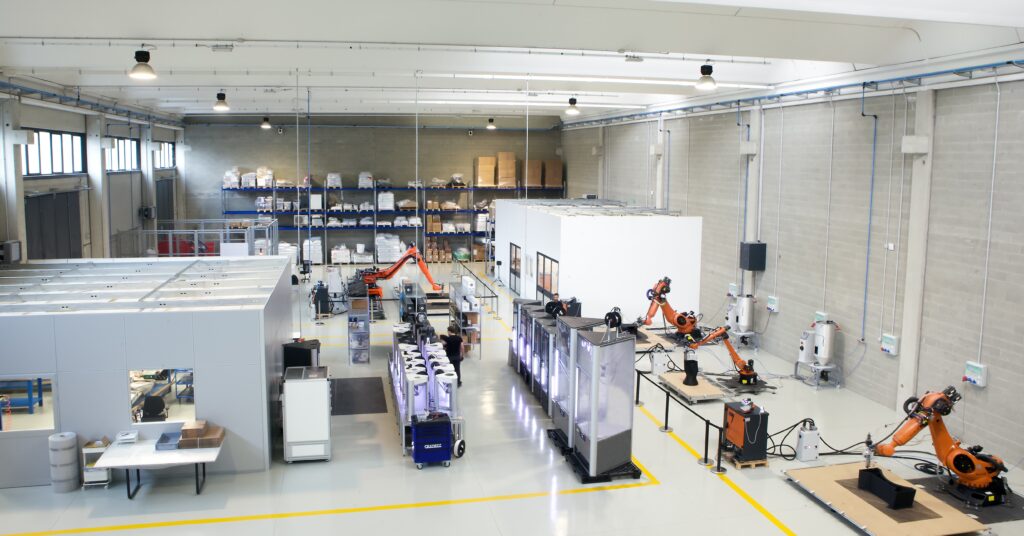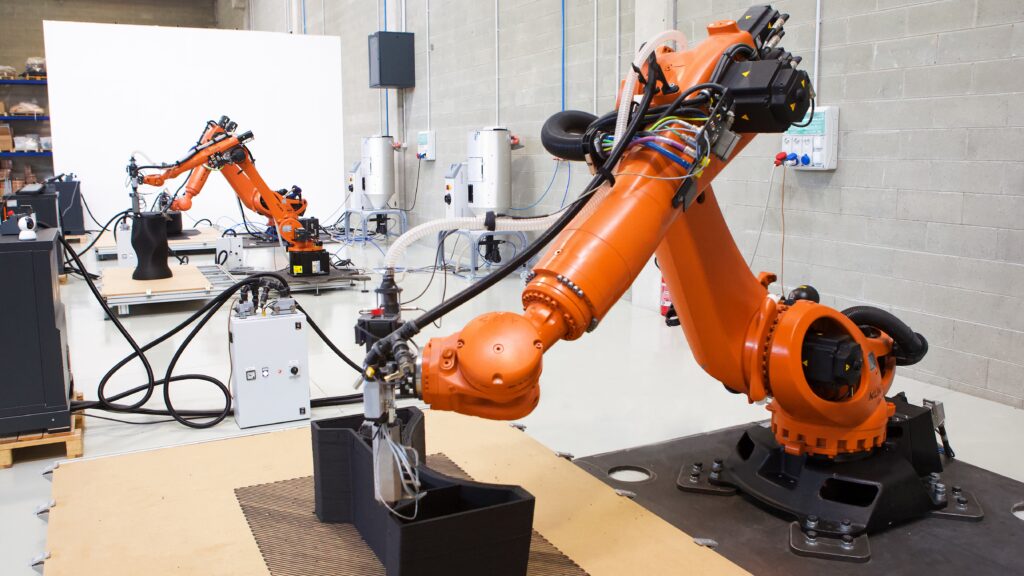I think it’s safe to say that 2023 is not the easiest time in history to run a startup. Alongside all the geopolitical volatility that was already present, the general tightening of credit markets across the globe in the last couple of years has made investors hypersensitive to any potential exposure to unpredictability, and far less willing to gamble on anything unproven.
On the other hand, the same context makes the companies that are still attracting investor interest stand out all the more, which helps bring clarity to an otherwise murky picture concerning where business innovation is headed in the future. Thus, news of the more than $11 million that the Italian-US additive manufacturing (AM) startup Caracol received in its Series A round this past March made it easy for me to keep the company in mind, and has kept me on the lookout for any updates on its activities.
Caracol produces the Heron, a platform for robotic arm pellet extrusion, which is an area of the AM sector that seems poised to grow very rapidly in the near future. The company had a very busy August, as it executed on plans to use its Series A funding to expand its global presence: Caracol’s North American headquarters in Austin, Texas is now officially operational, an announcement the company made at Formnext Forum’s inaugural event in North America.

I wanted to find out more about why a North American headquarters was such an important objective for Caracol to achieve, and how that fits into the company’s overall long-term plans, so I figured that Violetta Nespolo, the company’s chief marketing and strategy officer, was the perfect person to explain this to me. She’s been along for most of Caracol’s entire journey. The company was founded in 2017, and Nespolo joined the team in July 2019. Given the timeframe, she’s obviously seen Caracol endure and grow through some of the most chaotic macro conditions in recent memory. In the process, Nespolo has also helped guide the company through the fundamental transformation of its business model:
“At first, Caracol was a service provider, though we’ve always been focused on large format extrusion. Caracol began by printing larger furniture parts. It started slow, but eventually it grew into us developing a really high quality large format printer, which led clients to ask if they could access the technology. And by that time, that made sense to us as well, since the technology had matured. So transitioning into an OEM started from trying to understand what those clients needed — what were their applications, what were they trying to manufacture that they couldn’t before? …Today, we’re working with much tougher, much more advanced materials. We started off in the world of design, but now we’re working with clients in markets like aerospace: we’re qualifying tools for production for different OEMs here in Italy and elsewhere around Europe.”

Nespolo explained to me how entering one new market, as long as it’s the right one and you do it successfully, can lead to a ripple effect:
“When you unlock certain applications, it kind of just opens a world of potential users — for example, in the maritime sector. This was something we hadn’t worked on at all. Then we started with one client who asked, can we do this, can we do that, and then it kind of boomed on its own. Now it’s one of our key sectors. We have parts manufactured with our process that are being installed on yachts. That’s why we start with the applications, and then focus on making our system suitable for use in production.”
In addition to the full range of transport sectors (aerospace, rail, automotive, and maritime), Caracol has also branched out into other areas of heavy industry, like decarbonization and renewable energy. This makes sense not only because automation of large format manufacturing will be so important to helping the supply chains supporting lower carbon economies off the ground, but also because recycling is especially feasible for pellet extrusion AM:
“We’re involved with some very interesting projects in green energy, including helping to find ways to recycle the fiberglass from used wind turbines. Wind companies have these giant pieces of glass fiber that they don’t know what to do with — they just end up in landfill, usually. And now we’re finding ways to grind down the glass fiber, put it into a compound with another material like polypropylene, and we then we try to find new applications. So for example, we’re exploring smaller urban environment wind turbines, or wind turbines that can fit on factories. We’re also working with some brands on exploring what you could do on larger gas turbines and those sorts of things.”

Caracol’s growing foothold into such a diverse range of the sectors that are interested in large format AM is probably the key factor explaining why establishing a North American headquarters was such a priority for the company. Over the last year, in no small part due to major industrial policy enacted by the Biden administration and the US Congress, companies from all over the world have suddenly found the US and the Western hemisphere, generally, attractive markets to manufacture in again: in fact, Mexico has (at least for now) taken a slight lead over China to become the US’s largest trading partner. Thus, Texas, in particular, may be the best bet for a company looking for central accessibility to the greatest variety of verticals:
“We started working with US clients in 2019 and developed traction. So we started to think about setting up a US office, but we wanted Caracol to really be a local company, to make the products in the US. That is why we opened a facility where we can actually manufacture our systems. It allows us to work with local suppliers, allows us to build a network local to the US, and to fully leverage the fact that we have operations overseas. And then of course, Austin is interesting because it’s becoming a central hub for 3D printing, but in general, Texas is important for manufacturing in aerospace, in energy, and for several other sectors we’re working in, so it just made sense to have a foothold there. It allows us to be closer to many of our clients who already have our systems within their facilities, which enables us to support them more effectively.”
One bright side to emerging in such an uncertain economic landscape, perhaps, is that it teaches you to only aim to grow as quickly as can be justified by the present realistic potential for revenue. Among other reasons, this is because it gives businesses the best chance to be at peak financial health when new conditions for organic growth emerge.

Caracol is one of those rare startups that seems to have grown exactly as quickly as it should have since it started, growing application by application, sector by sector, and market by market. In addition to North America, Caracol has also been increasing its focus on the Gulf region, a market that seems like it’s about to start growing exponentially.
“We try to operate in such a way that the business is something that grows at a reasonable pace — not just hiring people for the sake of hiring people, but to fill the roles that need to be filled.” This should allow Caracol to avoid big rounds of layoffs like other startups, and to continue planting seeds with as many different new applications as possible: “We like the adaptability of working with many different sectors, even though there are certain sectors which are more interesting than others for the type of technology we provide. …We like the flexibility, and it keeps our jobs interesting.”
Being able to use the same hardware to handle as many different product types as possible is possibly AM’s biggest selling point long-term. In retrospect, Caracol looks wise to have cultivated this asset as its primary strength, and the fact that it did so seems to have put the company in ideal position to grow at exactly the right time. This year has been big for Caracol, but the company has plenty of reasons to expect much bigger years ahead.
Subscribe to Our Email Newsletter
Stay up-to-date on all the latest news from the 3D printing industry and receive information and offers from third party vendors.
Print Services
Upload your 3D Models and get them printed quickly and efficiently.
You May Also Like
Reinventing Reindustrialization: Why NAVWAR Project Manager Spencer Koroly Invented a Made-in-America 3D Printer
It has become virtually impossible to regularly follow additive manufacturing (AM) industry news and not stumble across the term “defense industrial base” (DIB), a concept encompassing all the many diverse...
Inside The Barnes Global Advisors’ Vision for a Stronger AM Ecosystem
As additive manufacturing (AM) continues to revolutionize the industrial landscape, Pittsburgh-based consultancy The Barnes Global Advisors (TBGA) is helping shape what that future looks like. As the largest independent AM...
Ruggedized: How USMC Innovation Officer Matt Pine Navigates 3D Printing in the Military
Disclaimer: Matt Pine’s views are not the views of the Department of Defense nor the U.S. Marine Corps Throughout this decade thus far, the military’s adoption of additive manufacturing (AM)...
U.S. Congress Calls Out 3D Printing in Proposal for Commercial Reserve Manufacturing Network
Last week, the U.S. House of Representatives’ Appropriations Committee moved the FY 2026 defense bill forward to the House floor. Included in the legislation is a $131 million proposal for...

































